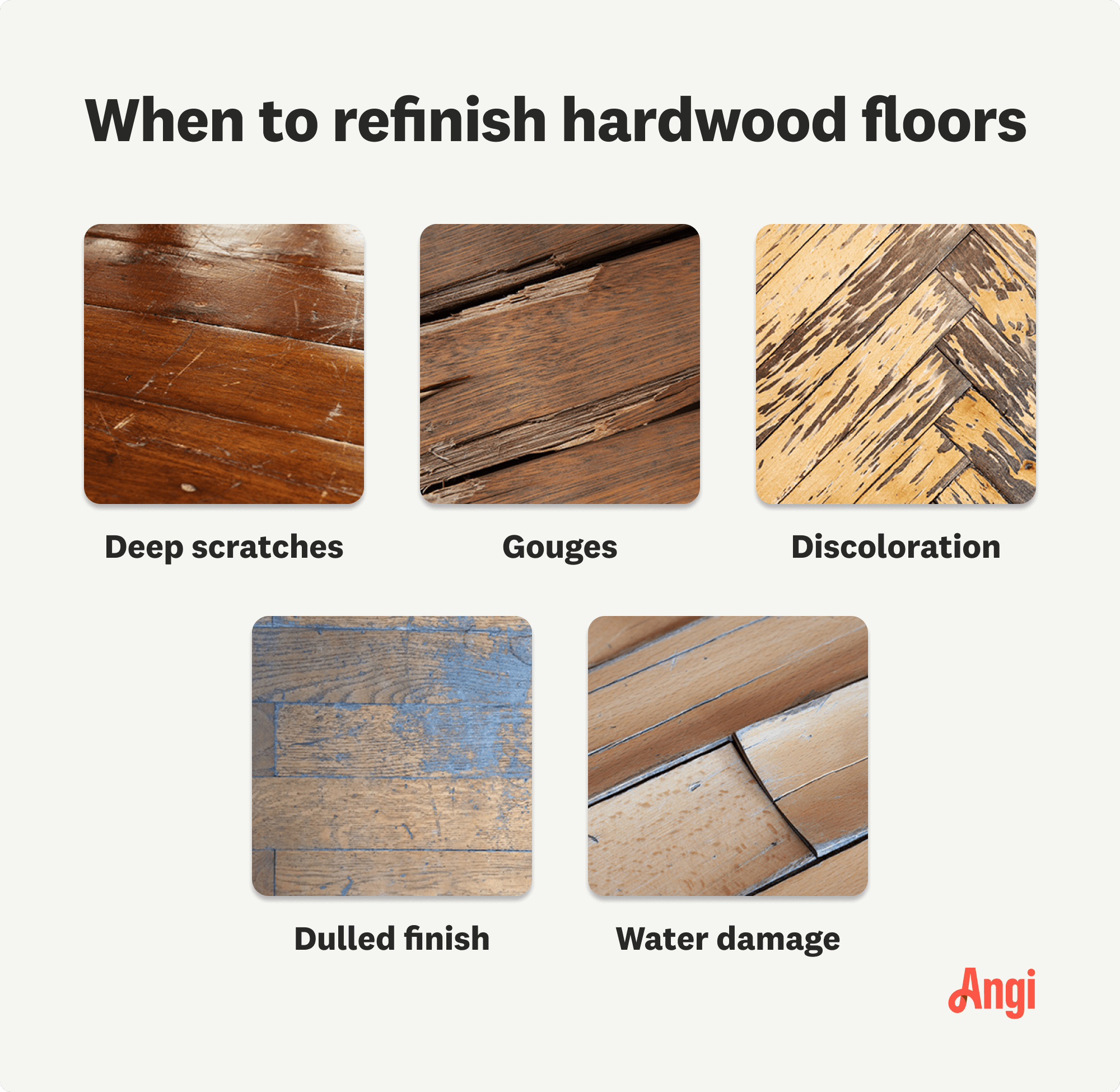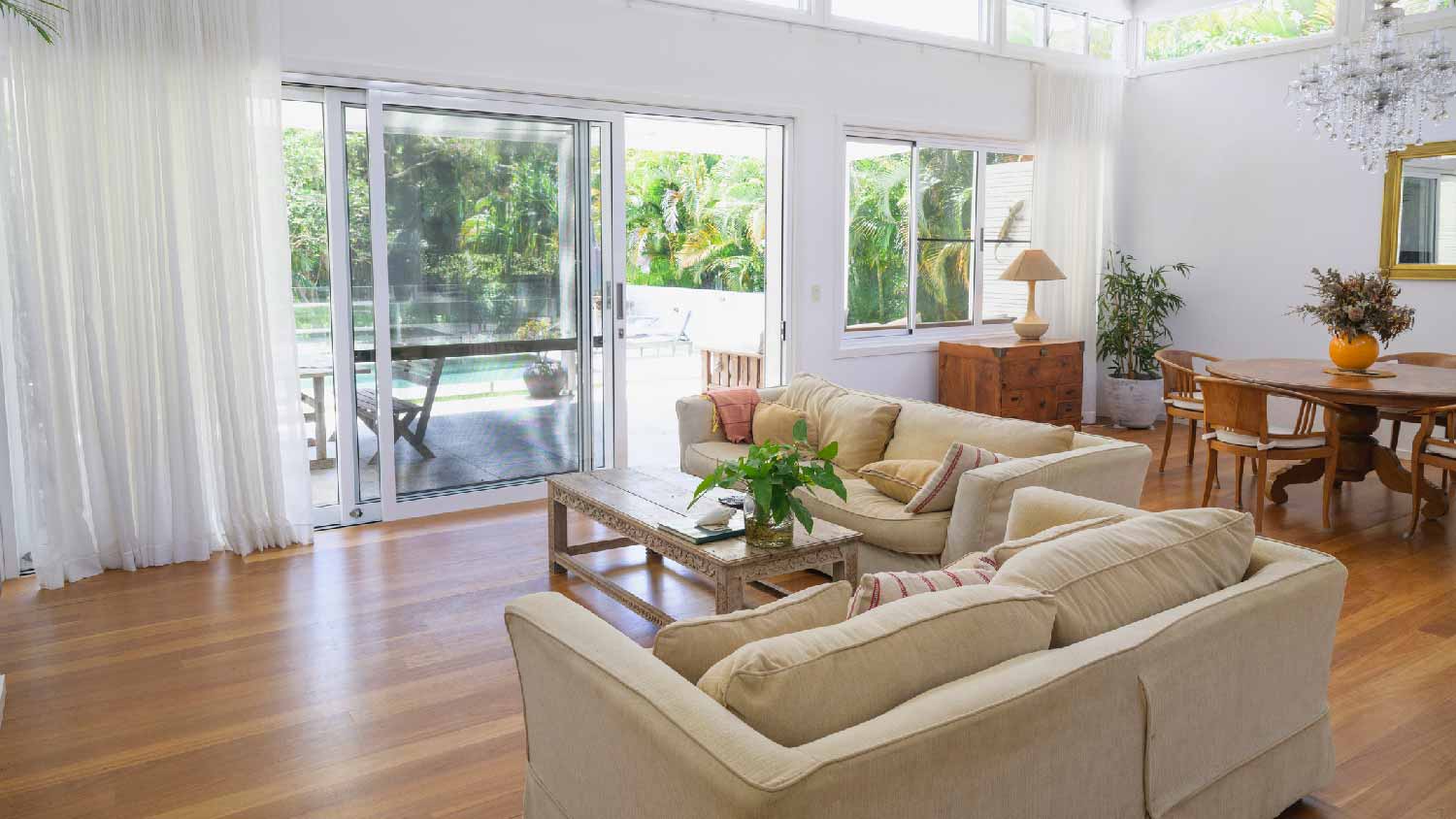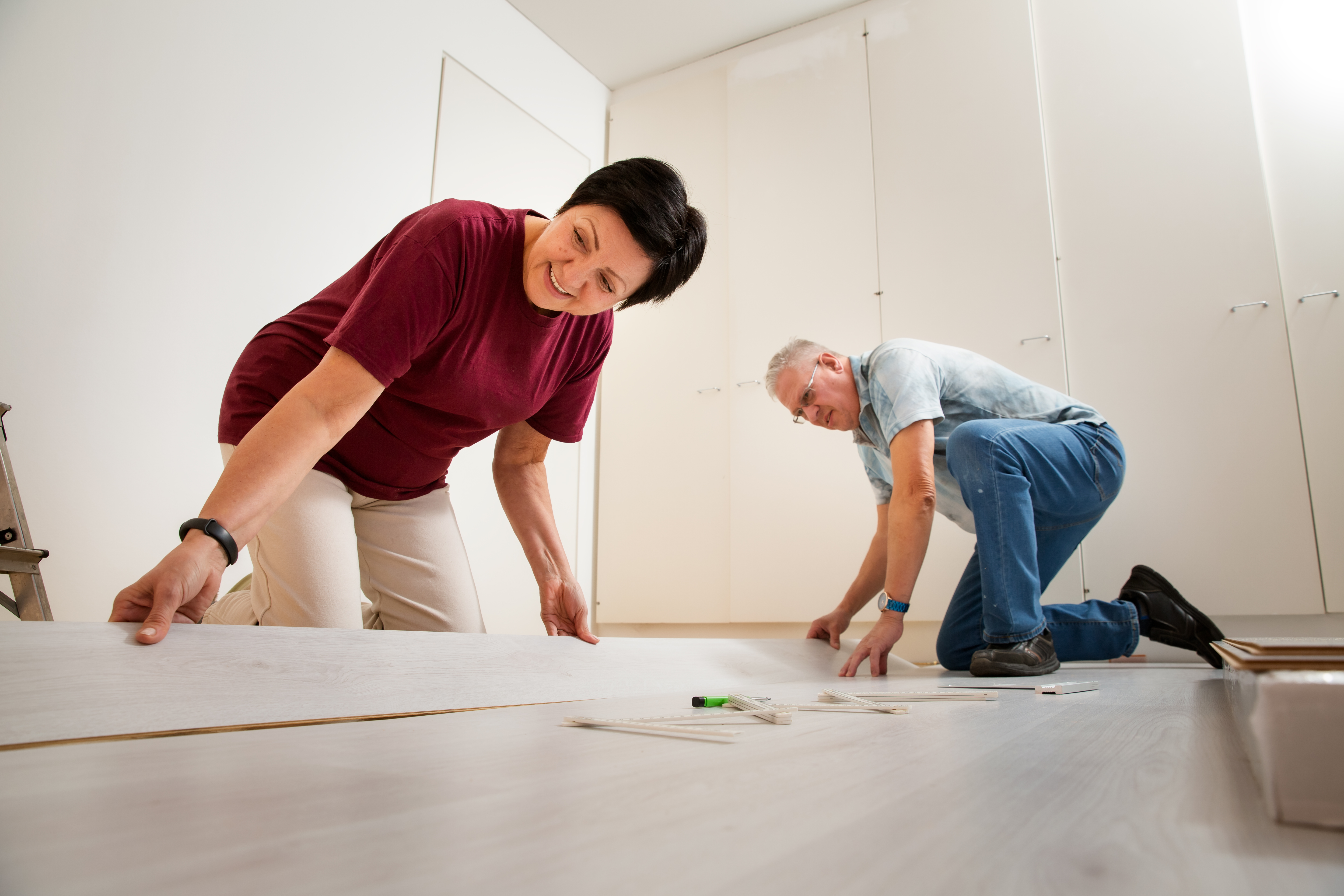
Hardwood floor repair costs depend on the problem. This guide breaks down common costs based on factors like the type of problem, repair method, and whether you hire a pro or DIY.
Hardwood floors should be even and luxurious, not buckled and bumpy
Hardwood floors can buckle when exposed to moisture and heat.
Buckling is the most severe type of hardwood floor damage.
There are six main causes of buckled hardwood floors.
Call a pro for major hardwood buckling.
Severe buckling usually requires floorboard replacement.
A perfectly maintained hardwood floor is the ultimate centerpiece, adding plenty of appeal to any living space. However, wood flooring is particularly finicky and is susceptible to all kinds of issues, including buckling.
Even worse? Severe buckling prevents your floor from shifting back to its original shape, and replacing hardwood flooring costs anywhere from $2,500 to $6,800. Mobile home floor repair costs may be less, depending on the damage. Hardwood floor buckling has several causes, and one or more may contribute to your flooring damage. Here are the six most common causes of buckling in hardwood flooring installations.
Hardwood flooring naturally expands when it is exposed to moisture and heat. But when there’s too much moisture and heat and walls prevent it from expanding out to the sides, it will expand upward. As floorboards continue to swell and rise up, separating from the subflooring and neighboring boards, they cause bumps and humps in the flooring surface. This is known as buckling.
Most often, buckling happens when the bottom of the floorboards is drier than the top of the boards. Excessive and ongoing humidity, extended flooding, and unaddressed water leaks are the most common culprits.
“In the southeastern U.S., where there are high temperature and high humidity months, we see a lot of damage to wood flooring,” says Robert Tschudi, Expert Review Board member and North Carolina-based home builder and remodeler. “The most obvious is ‘cupping,’ where the flooring bends to its natural shape. In those cases, we look for ways to drastically reduce the moisture level and often the warping/cupping will subside.”
Sometimes, buckling is temporary, with flooring going back to its original shape when you remove the cause of the buckling and give the flooring time to flatten out. Other times, the buckling stays the same or even gets worse as the floors dry or cool. In any case, buckling is one of the most extreme forms of hardwood floor damage, and you should deal with it immediately if it begins to happen to your floors.
Here are the most common culprits causing your floors to buckle.
While trees enjoy a nice rainy day, hardwood floors do not. Water and moisture are the number one cause of buckling floorboards. That’s because when floorboards get wet, the wood naturally swells to accommodate the moisture. All that contracting and expanding eventually leads to buckling and warping. “Water is extremely dangerous to wood flooring,” says Tschudi. “A malfunctioning water heater or refrigerator can spew gallons of water on a floor, damaging it before you even see it.”
Excessive and ongoing humidity in your home, flooding, leaky pipes, roof leaks, drainage problems, wet concrete slabs underneath, and a lack of ventilation are all common causes of water-based buckling of hardwood floors.
How to prevent it: Maintenance is key here. Keep an eye out for any long-lasting leaks from any appliances, pipes, the roof, excessive moisture in the crawl space, or just about anywhere else. If you notice a stubborn leak, shut off the offending appliance if applicable and call a plumber immediately. Also, avoid setting houseplants on wood flooring, and place area rugs underneath sinks. Keep in mind that buckling won’t apply to infrequent, small spills. If you’re clumsy, you don’t need to sweat it if you accidentally tip over your water cup, though you should still clean it up ASAP.
Water’s cousin, humidity, also causes buckling in wood floors. Any part of your home that suffers from higher-than-average humidity holds the potential for buckled wood flooring. Humidity is moisture, after all. The more moisture that comes into contact with hardwood, the more swelling it causes, leading to buckling. Unfortunately, wooden floors absorb moisture from the air, so the risk here is fairly high.
How to prevent it: There are several ways to reduce humidity in your home. Install high-grade dehumidifiers near the hardwood floors or increase ventilation with fans and an improved HVAC system. Some parts of the U.S. are simply more humid than others, such as Florida and Louisiana, so consider avoiding hardwood if you live in one of these areas.
Finally, keep hardwood away from humid parts of the home, such as bathrooms. Keep your home’s relative humidity level between 30% to 55%, or the humidity range recommended by your flooring manufacturer or for your specific type of hardwood flooring.
Humidity is not the only way Mother Nature works to buckle wood. Drastic temperature change is also a known culprit. Going from cold to hot and back again buckles hardwood in short order. Wood naturally expands with heat and contracts with cold, so a perfectly gorgeous set of hardwood planks could turn into a buckled and warped mess in just a few seasons without proper care and prevention.
How to prevent it: Limit exposure to the elements and temperature fluctuations. Maintain a healthy relative humidity in your home, and leverage your HVAC system so your living space is never too hot or too cold, no matter the temperature outside. If you have to pick between upgrading your heater or your air conditioner, go with the latter, as hot, sticky weather is more likely to cause buckling than cold.
An improperly installed hardwood floor is a recipe for disaster, including warping, buckling, and associated water damage. Poorly installed hardwood tends to be ill-fitted, with plenty of cracks and openings. Extreme weather conditions take full advantage of these issues, allowing moisture to fill these cracks. You know how this story ends—with a ruined and buckled floor.
How to prevent it: Perform serious research before hiring a flooring contractor to install hardwood flooring. Ask plenty of pertinent questions and, if possible, keep an eye on the technicians as they finish the work. Look for a well-vetted and licensed pro with plenty of experience with hardwood floors. Plus, if they offer a guarantee of some kind, even better.
This factor goes along with installation, but certain issues with your subfloors can lead to buckling of your hardwood flooring. Moist wood subfloors are a one-way ticket to buckle city, as are improperly dried concrete subfloors. In fact, many wood flooring manufacturers recommend against installing hardwood floors over concrete subfloors. If you insist on doing it, be sure your contractor puts down a thick vapor barrier first. If the subfloors are prone to moisture, it is only a matter of time before this moisture impacts the hardwood.
How to prevent it: Ask your contractor to test your subfloors for moisture content before installation. A seasoned pro knows to look at the subfloors, but it can’t hurt to mention. If the moisture content is too high, address the underlying issue before installing hardwood flooring. These problems range from leaks to humidity and beyond. Also, ask your pro about professionally drying and installing vapor barriers over concrete subfloor slabs before laying down the hardwood.
Acclimation means laying your wooden planks in the room before installation so they can become accustomed to your home’s average temperature and humidity levels. On average, acclimation is a process lasting two weeks, though there is debate on whether improper acclimation causes buckling. However, many believe installing planks that are too dry or too moist causes buckling in the long term.
Let flooring like hardwood and laminate acclimate to your home's humidity before installation to ensure it won’t warp or shift. Your flooring pro can guide you on how long to let it adapt.
How to prevent it: Talk to your pro about acclimation before scheduling an installation. It never hurts to let your planks sit in your home for two weeks before the procedure, though your contractor may consider it overkill. Your installer should also use completely dry and seasoned flooring, as green hardwood floors that haven’t yet dried will almost certainly buckle or have other structural problems as they cure.
It’s hard to miss the signs of buckled hardwood flooring: They usually take the shape of hills, valleys, grooves, or an undulating or wavy appearance on the surface of the floors. You may also see gaps, or the floorboards may press up and away from each other, causing the tongue-and-groove connections to be visible or come apart.
Other similar damage—like cupping, crowning, cracking, gapping, and lifting—can occur simultaneously or be mistaken for buckling. While each type of damage has its own causes and fixes, all are signs of a major problem you must deal with immediately. If you notice buckling or any other concerns in your hardwood flooring or if you have minor buckling that happens repeatedly, it’s best to call a local floor repair company right away to help you figure out what’s going on and how you can keep it from happening again.

If you catch the damage early and before it’s gone too far, you may be able to fix the source of the moisture (e.g., clean up pooled water, repair a leak, or return your home’s relative humidity to acceptable levels). Planks that have started to buckle may return to their normal size and shape. You may be able to help this process by slowly reducing the amount of humidity in the air and moisture in the planks by cautiously drawing down your home’s relative humidity and by placing heavy boxes or similar objects on buckled boards to help them flatten out.
However, the usual rules for how to repair hardwood floors may not apply to buckled flooring. If your flooring has severely buckled, there may not be any way to repair it. Instead, you may need to replace entire boards, small to large areas of affected flooring, or the entire floor, depending on the severity of the problem. This will be more than the cost of refinishing hardwood floors, but it will be less than entirely replacing your flooring.
It is usually best to call a professional hardwood flooring contractor to assess the damage and advise you on whether repair is possible or replacement is necessary. Since it’s a big decision, you may decide to get several opinions and quotes for service; three to five is standard in the construction industry.
Prevention is the best medicine, though it’s not always possible. Some older homes are simply too humid or prone to leaks, leading to hardwood buckling. Here is what to do if you notice buckles and warps in your precious hardwood.
If the buckling is in its infancy, try drying the damaged floorboards and seeing if they revert to their original shape.
We aren’t talking paper towels here. Get rid of moisture at every level, from the air by using a dehumidifier, from the wood planks with a cloth and fans, and even from accessible subfloors with fans and dehumidifiers. Wait a few days after this intensive drying procedure to check on the hardwood. If the buckling recedes, you are good to go. If not, more work is necessary.
If the buckling is minor and contained to just a few boards, you may be able to coax the floorboards back to their original shape and placement. After removing the source of the buckling (usually by drying the surface with cloths), and as you are drying the air and floorboards with fans and dehumidifiers, place heavy boxes or similar heavy items on top of buckled boards. Don’t completely cover the area since you need the boards and area around and beneath them to continue drying. However, applying this heavy pressure to warped boards may be enough to press them back into place.
Fixing more severely buckled floorboards is sometimes possible, though it is usually time-intensive and complicated, and your success isn’t guaranteed. You’ll need several tools, including a circular saw, drill with a spade bit, paintbrush, pry bar, and more. You’ll also need copious materials, including replacement planks, scrap lumber, fine-grit sandpaper, and a high-quality staining agent. In other words, this process is for those with hardwood installation or replacement experience only.
Don’t fret if the repair job is out of your league, as hardwood floors require precise installation and repair. Consult a flooring contractor and gather repair estimates. The entire floor rarely needs replacement. More often than not, the pro merely removes and replaces any impacted planks and areas.
Repairing hardwood floors costs $65 to $100 per hour for labor or around $3 to $8 per square foot of necessary repairs. This tends to be a more expensive flooring repair job; in many cases, buckled hardwood floors require a total replacement. Replacing hardwood flooring costs anywhere from $2,500 to $7,000, depending on square footage. Sometimes, buckling is temporary, and your flooring will return to its original shape when the cause of buckling is removed.
From average costs to expert advice, get all the answers you need to get your job done.

Hardwood floor repair costs depend on the problem. This guide breaks down common costs based on factors like the type of problem, repair method, and whether you hire a pro or DIY.

It’s impossible to keep floors damage-free over the years. Thankfully, the cost to refinish hardwood floors is far less than the price tag to replace them altogether.

Here’s what you should expect to pay when renting an orbital, drum, vibrating, or edging floor sander—as well as where you can rent them and what else to know.

Hardwood floor resurfacing and refinishing are similar but produce different results. Your budget and timeline can help you decide which is better for your floors.

Can you install hardwood floors over tile? The answer is yes, if you do it the right way. Here’s everything you need to know to upgrade your floors.

Before beginning a hardwood floor refinishing project, start with these important questions to ask your hardwood floor refinisher about the process.